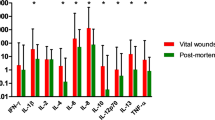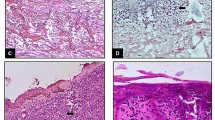Abstract
The timing of skin wounds is one of the most challenging problems in forensic pathology. In the first minutes or hours after infliction, histological examination fails to determine whether a wound was sustained before or after death. The aim of this study was to evaluate the use of three immunohistochemical markers (FVIIIra, CD15, and tryptase) for the interpretation of the timing of cutaneous stab wounds. We evaluated these markers in intravital wounds from autopsy cases (n = 12) and surgical specimens (n = 58). As controls, we used normal skin samples from autopsies (n = 8) and an original ex vivo surgical human model of recent postmortem wounds (n = 24). We found overexpression of FVIIIra in 100 % of vital wounds, but also in 53 % of the controls. The number of CD15-positive cells was higher in wound margins than in internal controls (p < 0.0001) and was significantly correlated with the time interval between incision and devascularization (p = 0.0005; minimal time for positivity, 9 min). Using the anti-tryptase antibody, we found that the mast cell degranulation rate was higher in wound margins (p < 0.0001) and correlated with the time interval (minimal time, 1 min). The sensitivity and specificity for the diagnosis of vitality were respectively 100 and 47 % for FVIIIra, 47 and 100 % for CD15, and 60 and 100 % for tryptase. The inter-observer agreement coefficients were 0.68 for FVIIIra, 0.90 for CD15, and 0.46 for tryptase. Finally, we demonstrated that these markers were not reliable in putrefied or desiccated specimens. In conclusion, CD15 and tryptase, but not FVIIIra, may be useful markers for differentiating recent antemortem from postmortem injuries.




Similar content being viewed by others
References
van de Goot FR (2008) The chronological dating of injury. In: Rutty GN (ed) Essentials of autopsy practice. Springer, London, pp 167–181
Oehmichen M (2004) Vitality and time course of wounds. Forensic Sci Int 144(2–3):221–231. doi:10.1016/j.forsciint.2004.04.057
Prinsloo I, Gordon I (1951) Post-mortem dissection artifacts of the neck; their differentiation from ante-mortem bruises. S Afr Med J 25(21):358–361
Strejc P, Pilin A, Klir P, Vajtr D (2011) The origin, distribution and relocability of supravital hemorrhages. Soud Lek 56(2):18–20
Cecchi R (2010) Estimating wound age: looking into the future. Int J Legal Med 124(6):523–536. doi:10.1007/s00414-010-0505-x
Grellner W, Madea B (2007) Demands on scientific studies: vitality of wounds and wound age estimation. Forensic Sci Int 165(2–3):150–154. doi:10.1016/j.forsciint.2006.05.029
Ishida Y, Kimura A, Nosaka M, Kuninaka Y, Takayasu T, Eisenmenger W, Kondo T (2012) Immunohistochemical analysis on cyclooxygenase-2 for wound age determination. Int J Legal Med 126(3):435–440. doi:10.1007/s00414-012-0685-7
Ma WX, Yu TS, Fan YY, Zhang ST, Ren P, Wang SB, Zhao R, Pi JB, Guan DW (2011) Time-dependent expression and distribution of monoacylglycerol lipase during the skin-incised wound healing in mice. Int J Legal Med 125(4):549–558. doi:10.1007/s00414-011-0567-4
Takamiya M, Fujita S, Saigusa K, Aoki Y (2008) Simultaneous detection of eight cytokines in human dermal wounds with a multiplex bead-based immunoassay for wound age estimation. Int J Legal Med 122(2):143–148. doi:10.1007/s00414-007-0183-5
Dressler J, Bachmann L, Koch R, Muller E (1999) Enhanced expression of selectins in human skin wounds. Int J Legal Med 112(1):39–44
Kondo T, Ohshima T, Eisenmenger W (1999) Immunohistochemical and morphometrical study on the temporal expression of interleukin-1alpha (IL-1alpha) in human skin wounds for forensic wound age determination. Int J Legal Med 112(4):249–252
Betz P, Nerlich A, Wilske J, Tubel J, Penning R, Eisenmenger W (1993) The immunohistochemical localization of alpha 1-antichymotrypsin and fibronectin and its meaning for the determination of the vitality of human skin wounds. Int J Legal Med 105(4):223–227
Betz P, Nerlich A, Wilske J, Tubel J, Wiest I, Penning R, Eisenmenger W (1992) Immunohistochemical localization of fibronectin as a tool for the age determination of human skin wounds. Int J Legal Med 105(1):21–26
An JL, Ishida Y, Kimura A, Kondo T (2011) Immunohistochemical examination of intracerebral aquaporin-4 expression and its application for differential diagnosis between freshwater and saltwater drowning. Int J Legal Med 125(1):59–65. doi:10.1007/s00414-010-0523-8
Fracasso T, Pfeiffer H, Kohler H, Wieseler S, Hansen SD, Jentgens L, Sauerland C, Schmeling A (2011) Immunohistochemical expression of fibronectin and C5b-9 in the myocardium in cases of fatal ethanol intoxication. Int J Legal Med 125(4):537–542. doi:10.1007/s00414-011-0547-8
Fracasso T, Pfeiffer H, Michaud K, Kohler H, Sauerland C, Schmeling A (2011) Immunohistochemical expression of fibronectin and C5b-9 in the myocardium in cases of carbon monoxide poisoning. Int J Legal Med 125(3):377–384. doi:10.1007/s00414-010-0512-y
Bohnert M, Anderson J, Rothschild MA, Bohm J (2010) Immunohistochemical expression of fibronectin in the lungs of fire victims proves intravital reaction in fatal burns. Int J Legal Med 124(6):583–588. doi:10.1007/s00414-010-0437-5
Grellner W, Madea B, Kruppenbacher JP, Dimmeler S (1996) Interleukin-1 alpha (IL-1 alpha) and N-formyl-methionyl-leucyl-phenylalanine (FMLP) as potential inducers of supravital chemotaxis. Int J Legal Med 109(3):130–133
Grellner W, Dimmeler S, Madea B (1998) Immunohistochemical detection of fibronectin in postmortem incised wounds of porcine skin. Forensic Sci Int 97(2–3):109–116
Dressler J, Bachmann L, Strejc P, Koch R, Muller E (2000) Expression of adhesion molecules in skin wounds: diagnostic value in legal medicine. Forensic Sci Int 113(1–3):173–176
Sadler JE (1998) Biochemistry and genetics of von Willebrand factor. Annu Rev Biochem 67:395–424. doi:10.1146/annurev.biochem.67.1.395
Hausmann R, Betz P (2000) The time course of the vascular response to human brain injury—an immunohistochemical study. Int J Legal Med 113(5):288–292
Taylor ME, Drickamer K (2007) Paradigms for glycan-binding receptors in cell adhesion. Curr Opin Cell Biol 19(5):572–577
Pinkus GS, Thomas P, Said JW (1985) Leu-M1—a marker for Reed–Sternberg cells in Hodgkin’s disease. An immunoperoxidase study of paraffin-embedded tissues. Am J Pathol 119(2):244–252
Lo SK, Golenbock DT, Sass PM, Maskati A, Xu H, Silverstein RL (1997) Engagement of the Lewis X antigen (CD15) results in monocyte activation. Blood 89(1):307–314
Hausmann R, Kaiser A, Lang C, Bohnert M, Betz P (1999) A quantitative immunohistochemical study on the time-dependent course of acute inflammatory cellular response to human brain injury. Int J Legal Med 112(4):227–232
Turillazzi E, Vacchiano G, Luna-Maldonado A, Neri M, Pomara C, Rabozzi R, Riezzo I, Fineschi V (2010) Tryptase, CD15 and IL-15 as reliable markers for the determination of soft and hard ligature marks vitality. Histol Histopathol 25(12):1539–1546
Cecchi R, Aromatario M, Frati P, Lucidi D, Ciallella C (2012) Death due to crush injuries in a compactor truck: vitality assessment by immunohistochemistry. Int J Legal Med 126(6):957–960. doi:10.1007/s00414-012-0761-z
Abraham WM (2002) Tryptase: potential role in airway inflammation and remodeling. Am J Physiol Lung Cell Mol Physiol 282(2):L193–L196. doi:10.1152/ajplung.00429.2001
Bonelli A, Bacci S, Norelli GA (2003) Affinity cytochemistry analysis of mast cells in skin lesions: a possible tool to assess the timing of lesions after death. Int J Legal Med 117(6):331–334. doi:10.1007/s00414-003-0396-1
Oehmichen M, Gronki T, Meissner C, Anlauf M, Schwark T (2009) Mast cell reactivity at the margin of human skin wounds: an early cell marker of wound survival? Forensic Sci Int 191(1–3):1–5. doi:10.1016/j.forsciint.2009.05.020
Acknowledgments
The authors thank Mrs. Dominique Meng, Mrs. Arielle Chapelet, Mr. Alain Behm, and all the team of the Department of Pathology (Hôpital Central, CHU Nancy) for technical support and Mrs. Jacqueline Zevnick and Dr Jonathan Hayes for reviewing the manuscript.
Conflict of interest
The authors declare that they have no conflict of interest.
Author information
Authors and Affiliations
Corresponding author
Additional information
Jean-Michel Vignaud and Laurent Martrille contributed equally.
Rights and permissions
About this article
Cite this article
Gauchotte, G., Wissler, MP., Casse, JM. et al. FVIIIra, CD15, and tryptase performance in the diagnosis of skin stab wound vitality in forensic pathology. Int J Legal Med 127, 957–965 (2013). https://doi.org/10.1007/s00414-013-0880-1
Received:
Accepted:
Published:
Issue Date:
DOI: https://doi.org/10.1007/s00414-013-0880-1




